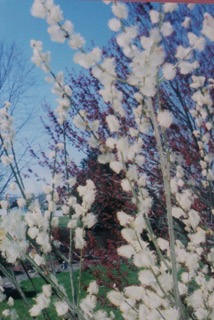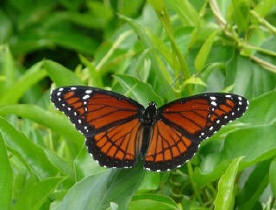
(3/3) The American Pussy Willow is a great example of how a native plant provides habitat and supports native wildlife.
Several years ago, a friend stopped by my garden with one Pussy Willow twig in her hand. She told me to just stick it into some damp soil and it would grow. I picked a spot in a slightly damp area, and stuck it in. It quickly took root and leafed out, and my pussy willow bush was born. It produced catkins the very next year, and, for a while, I would cut them all off
to bring inside. Eventually, I began to learn about the many values of native plants, and started reading about my pussy willow. I learned that it is an American Native whose botanical name is Salix discolor, hardy in zones 4-8.
It likes to grow in damp soil and will grow very deep taproots that take up a lot of water. For this reason, it is a great plant to include in a rain garden or any place that tends to stay wet after a heavy rain. Unlike many Pennsylvania native plants, it does not require acidic soil.
It is Dioecious (die A shus), meaning that male and female parts are found on different plants. The males have the larger, showier catkins, while the female catkins tend to be smaller and greenish. What most people think of as pussy willows are actually the flowering parts of the plant. Those fuzzy "fur coats" are keeping the reproductive parts of the plant warm. Some
birds, especially hummingbirds, use that fuzzy softness to line their nests.
 If you like to save the catkins for a spring decoration in the house, cut them before the pollen appears, and do not put them in water. They will dry, and stay nice for years. They are also nice to use in outdoor pots for accent and height with other spring flowers.
If you like to save the catkins for a spring decoration in the house, cut them before the pollen appears, and do not put them in water. They will dry, and stay nice for years. They are also nice to use in outdoor pots for accent and height with other spring flowers.
However, be sure to just take a few, and leave the rest if you enjoy seeing butterflies and songbirds in your garden. The fact that the Pussy Willow blooms so early makes it a very valuable food source for wildlife. The early March catkins provide one of the first-of-the-season nectar sources for pollinators. The insects, in turn, provide a smorgasbord for songbirds.
The birds, especially chickadees and goldfinches, lock to the bush looking for dinner. The insects provide much needed protein.
You know you have a male plant when the catkins begin to look yellow. This is the pollen that is being held on the tips of the now-formed anthers. The Willow cannot be pollinated by wind. It needs insect pollination, and the insects are quickly drawn to its strongly scented nectar. Now is when the bird watching entertainment begins! My pussy willow is just outside my
sunroom window, and I watch those birds come and peck at the catkins like they are attacking them, eventually knocking them right off the plant!
 The Pussy Willow hosts several species of butterflies, one of which is the Viceroy. The Viceroy looks almost exactly like a Monarch. The Viceroy has a thin, black line that runs across its lower wings like a necklace. Unlike the monarch who migrates to Mexico, the Viceroy is a common Pennsylvania resident that
hosts on Willow. The female lays her eggs on the tip of the willow leaf. Soon the egg hatches, and the first instar (tiny caterpillar) appears. If it is fall, and cold weather is approaching, the little caterpillar rolls itself in a leaf, and, as the leaves wither, curl, and drop off the plant, the tiny caterpillar hangs on, and drops with the leaf. There it stays until
spring. In early spring as leaves are budding, the caterpillar climbs back up the bush and begins eating before going into it chrysalis. Soon, you should begin to see Viceroy Butterflies.
The Pussy Willow hosts several species of butterflies, one of which is the Viceroy. The Viceroy looks almost exactly like a Monarch. The Viceroy has a thin, black line that runs across its lower wings like a necklace. Unlike the monarch who migrates to Mexico, the Viceroy is a common Pennsylvania resident that
hosts on Willow. The female lays her eggs on the tip of the willow leaf. Soon the egg hatches, and the first instar (tiny caterpillar) appears. If it is fall, and cold weather is approaching, the little caterpillar rolls itself in a leaf, and, as the leaves wither, curl, and drop off the plant, the tiny caterpillar hangs on, and drops with the leaf. There it stays until
spring. In early spring as leaves are budding, the caterpillar climbs back up the bush and begins eating before going into it chrysalis. Soon, you should begin to see Viceroy Butterflies.
Another butterfly that will host on the Pussy Willow is the Mourning Cloak. This is a large butterfly. It has dark brown/maroon wings that have a cream colored ragged edge. The Mourning Cloak is one of the very few butterflies that winter over in Pennsylvania as an adult butterfly. It will crawl into a small crevice, often the bark of a tree, and hibernate. In the
spring, it emerges from hibernation and mates. The female then then lays her eggs on a pussy Willow, or one of its other acceptable host plants.
Now, when the naturalists tell you not to be so quick to clean up your garden, you will understand what they are talking about. If you go out there and clean up all the Willow leaves when they fall, or cut off every catkin in the spring, you will likely miss this wonderful example of nature unfolding before your eyes.
One last amazing fact about this native plant. Early people figured out that chewing on willow leaves relieved fevers and pain, and used this remedy long before Hippocrates recorded its use somewhere around 400 B.C. During the 1800’s scientists isolated the pain-killing ingredient, calling it salicin (from Salix), and the Bayer Company in Germany was the first to
market it as aspirin.